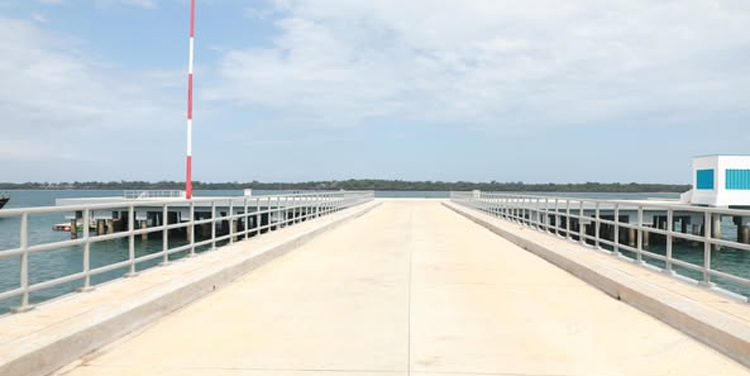The construction of the Shimoni Fish Port in Kwale County is now complete, marking a historic milestone in Kenya’s efforts to unlock the vast economic potential of the Blue Economy. Senior officials from the Kenya Ports Authority (KPA) conducted a final inspection tour of the state-of-the-art facility recently, ahead of its official commissioning, signaling a new era for Kenya’s marine fisheries sector and coastal economy.
The KSh2.6 billion facility, Kenya’s first industrial port dedicated exclusively to fisheries, has been strategically designed to stimulate economic growth by increasing fish production, processing, and value addition for both domestic consumption and regional exports.
Located near the world-renowned Kisite-Mpunguti Marine Park, the port features a modern jetty measuring 75 meters by 30 meters, a 135-meter-long causeway, and berthing space for two fishing vessels simultaneously.
It is equipped with a wide array of critical infrastructure, including a fish processing plant, cold storage units, reefer stations, a bio-digester, an ice-making plant, a wastewater management system, and a power substation, ensuring a seamless value chain from ocean to market.
The completion of the Shimoni Fish Port is expected to have profound economic ripple effects for the local and national economy. By enabling efficient handling, storage, and processing of marine catches, the port will significantly reduce post-harvest losses, currently a major constraint for artisanal fishers along the Kenyan coast.
With marine fisheries contributing approximately 26,000 tonnes annually, which is only 17% of Kenya’s total fish production, the Shimoni port is seen as a game-changer that could help unlock the sector’s untapped potential, estimated by the Kenya Fisheries Services (KFS) at over 300,000 tonnes per year.
“This aligns with President William Ruto’s broader plan to boost incomes, improve food security, and generate employment through sustainable exploitation of Indian Ocean resources,” KPA Managing Director Captain William Ruto said.
The facility is also poised to attract investment in Special Economic Zones (SEZs) focused on fish processing and exports, enhancing Kenya’s competitive edge in the regional seafood market and opening up new trade opportunities. As the global demand for sustainably sourced seafood rises, Shimoni port positions Kenya as a viable and modern fisheries hub on the Western Indian Ocean rim.
“Moreover, the project supports diversification of Kenya’s port infrastructure, complementing the commercial seaports of Mombasa and Lamu, with a specialized facility tailored for the blue economy,” Cap. Ruto said, adding that a future shipyard with floating docks and vessel maintenance services is planned, offering additional maritime-related income streams and reducing reliance on foreign service hubs.
For the communities of Shimoni and the neighboring Wasini Island, long reliant on artisanal fishing, the port heralds new hope. According to project coordinator James Rai, the facility is designed to uplift the socio-economic well-being of these coastal communities by providing jobs in fishing, processing, logistics, and port services.
“This port will be a game-changer,” said Rai. “Beyond infrastructure, it’s about empowering the people of Shimoni and surrounding areas to participate meaningfully in the blue economy.”
Key amenities in the final stages of completion include a fish meal plant, water storage tanks, ablution blocks, a perimeter fence, and access roads, ensuring the port is not only efficient but also environmentally sustainable and community friendly.
Kenya’s Exclusive Economic Zone (EEZ), part of the broader Western Indian Ocean, which generates over KSh2.2 trillion annually in economic output, remains vastly underexploited. Kenya is entitled to about 20% of this, but challenges such as inadequate fishing gear, shallow-sea operations, and dominance by Distant Water Fishing Nations (DWFNs) have limited local benefits.
The Shimoni port represents a shift toward reclaiming economic sovereignty over marine resources. Situated within the rich tuna belt—home to 25% of global tuna catch—the facility provides the infrastructure needed for local fishers and domestic firms to finally tap into lucrative offshore fisheries.
Former President Uhuru Kenyatta’s 2017 suspension of foreign trawler licenses underscored Kenya’s commitment to developing its capacity in the sector. The new port builds on this policy by creating conditions for increased local fish processing, estimated to multiply economic returns sevenfold and curb the KSh10 billion lost annually to illegal foreign fishing.
Industry players have welcomed the project as a vital link in Kenya’s marine development strategy. It not only expands the country’s port network but also strengthens its bargaining power in international fisheries agreements by demonstrating improved domestic capacity.
“With construction now complete and operationalization imminent, the Shimoni Fish Port stands as a landmark investment in Kenya’s blue economy—creating jobs, boosting exports, increasing food security, and driving sustainable development in the coastal region and beyond,” said Gilbert Nzai, a fish trader in Mombasa.
This article was published by Githua Kihara, an editorial consultant for FEAFFA’s Freight Logistics Magazine. For any inquiries, please contact us via email at editorial@feaffa.com or freightlogistics@feaffa.com, or reach out to Andrew Onionga directly at onionga@feaffa.com / +254733780240.





